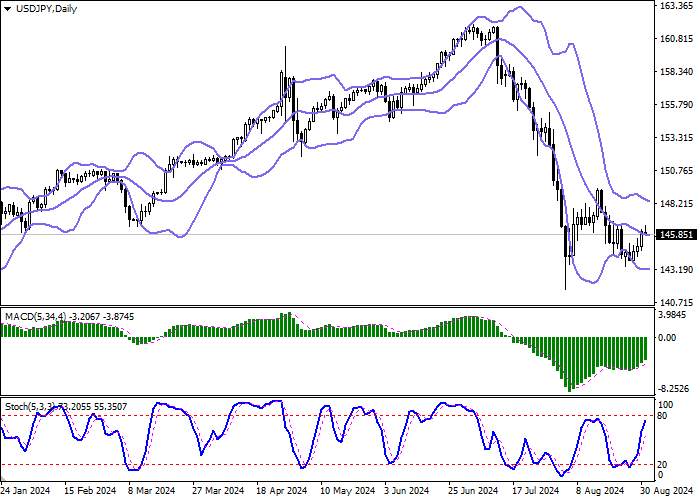Current trend
The USD/JPY pair shows ambiguous dynamics, consolidating near 146.00. "Bulls" remain under some pressure at the start of the week as US markets are closed for Labor Day and market participants gradually prepare for the release of the final August labor market report on Friday. Projections suggest Nonfarm Payrolls will increase from 114.0 thousand to 163.0 thousand and Average Hourly Earnings will rise from 0.2% to 0.3%, while the Unemployment Rate could decline from 4.3% to 4.2%.
Labor market data, along with inflation statistics, could have a significant impact on the US Federal Reserve's future monetary policy decisions. The main scenario currently being considered is a cut in the interest rate in September by only 25 basis points, but the probability of a correction of the rate by –50 basis points increased after the publication of inflation data last Friday: the Core Personal Consumption Expenditures Price Index in July in annual terms added another 2.6%, while analysts expected 2.7%, and in monthly terms it remained at the previous level of 0.2%, as expected.
Japanese data that hit the market on Friday were mixed, with the Tokyo Consumer Price Index rising to 2.6% from 2.2% in August, while the CPI excluding Fresh Food and Energy rose to 1.6% from 1.5%. In turn, the Unemployment Rate accelerated from 2.5% to 2.7%, while Retail Sales, on the contrary, slowed down significantly from 3.8% to 2.6% with a forecast of 2.9%.
Bank of Japan Deputy Governor Himino Ryozo said stability in financial markets requires closer monitoring after the central bank adjusted interest rates in late July, as the sharp fall in the NI 225 index will have a major impact on the banking system as financial institutions now hold fewer stocks than before. While analysts see increased borrowing costs as inevitable, the exact timing and extent of these moves depend on a variety of factors, including inflation trends, the state of the labor market, and external economic risks.
Support and resistance
In the daily chart, Bollinger Bands are reversing horizontally. The price range is slightly narrowed, remaining spacious enough for the current market activity. MACD grows, preserving a stable buy signal (located above the signal line). Stochastic shows similar dynamics; however, the indicator line is rapidly approaching its highs, indicating the risks of the US currency being overbought in the ultra-short term.
Resistance levels: 147.00, 148.21, 149.50, 150.50.
Support levels: 146.00, 145.00, 144.00, 143.35.


Trading tips
Long positions can be opened after a breakout of 147.00 with the target of 149.00. Stop-loss — 146.00. Implementation time: 2-3 days.
The return of a "bearish" trend with the breakdown of 145.00 may become a signal for new short positions with the target at 143.00. Stop-loss — 146.00.





Hot
No comment on record. Start new comment.